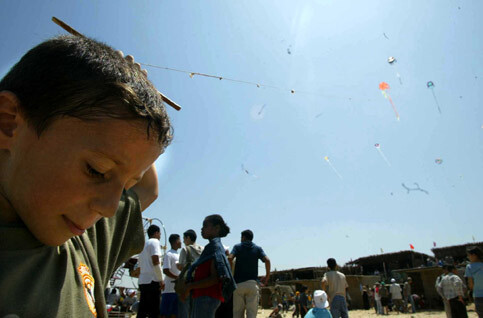The Electronic Intifada 16 June 2008

Children flying kites in the Gaza Strip. (Mohammed Omer)
GAZA CITY, 15 June (IPS) - Mahmoud Abu Teior, 13, knows it’s Abdullah’s kite up in the skies, though he has never seen Abdullah. But that kite rises into the skies from across the Egyptian side of the border across from Gaza. And, Mahmoud knows Abdullah’s voice because they speak sometimes. They have never met, and likely never will, but they are connected through their kites.
It’s that time of the year. The holidays bring scores of children to play together — across the dividing line. And despite the iron wall of separation, they form friendships.
Mahmoud has always known the border as a playground. This is where the family home was before it was demolished by Israel to make room for the border wall. “I always come here because this is where our house used to be,” he says, launching his kite.
Most children still play from “home,” where Block O, Yebna, Block J, or the al-Salam neighborhood used to be. The playground is that strip of no man’s land known as the Philadelphia corridor, where more than 2,400 homes were razed ahead of the “disengagement” by Israel in 2005. That same “disengagement” made about 16,800 people homeless here, according to UN figures.
Only kites can now cross the border. And up in the skies one can tell some of the Gaza kites apart. They are the ones made with newspapers and plastic bags, with some thorns stuck on for the dogfight that happens in the sky. The usual materials like paper and glue used to make a kite are scarce in Gaza.
Khalid Zanoun, 12, like the others, always picks the spot where his house once stood. Up in the skies, he suddenly loses his kite in a dogfight. “He ran away from me!” he screams, looking at his disappearing kite, fists clenched. But soon he is beaming again, preparing another kite for the next battle with his unseen mates on the other side.
Curiosity led him some time back to scale the wall and see what his mates look like. “This is not allowed any more,” he says. “The Hamas guards on our side and the Egyptian border guards on the other stop us.”
Not entirely, though, because boys will be boys. If nothing, they climb up just to say hello to the Egyptian guards.
It’s the better world on the other side. The Egyptian boys have better kites, and they have shoes. In Gaza, most children run barefoot on the sizzling hot soil. Shoes have been priced out of reach for most people, as so many things are nowadays as a result of the Israeli siege.
Mahmoud has four brothers working in Egypt. He dreams of joining them one day, of working in Egypt as an engineer, and not as day laborers as they do. “I have been to Egypt once,” he says. That is when the border was breached for a few days in January. “I loved it.”
But he’s not so sure he can become an engineer. The family has no money to send him to university. His family came here as refugees in 1948 when Israel was created on the land where they lived. Now they have become homeless again, and are back in a refugee camp.
The UN agency for Palestine refugees, UNRWA, helped re-house the families, and helps even to make some summer games possible for children. But it is hard to provide for about a quarter of a million children in Gaza.
Another boy comes up to join Mahmoud. He lifts his shirt to show a wound he received from shrapnel during an Israeli assault. He too lost his home. Everyone knows why. But for the moment, his thoughts are on his kite.
All rights reserved, IPS - Inter Press Service (2008). Total or partial publication, retransmission or sale forbidden.
Related Links





